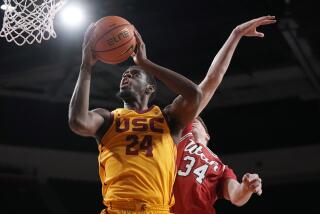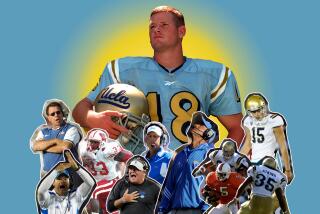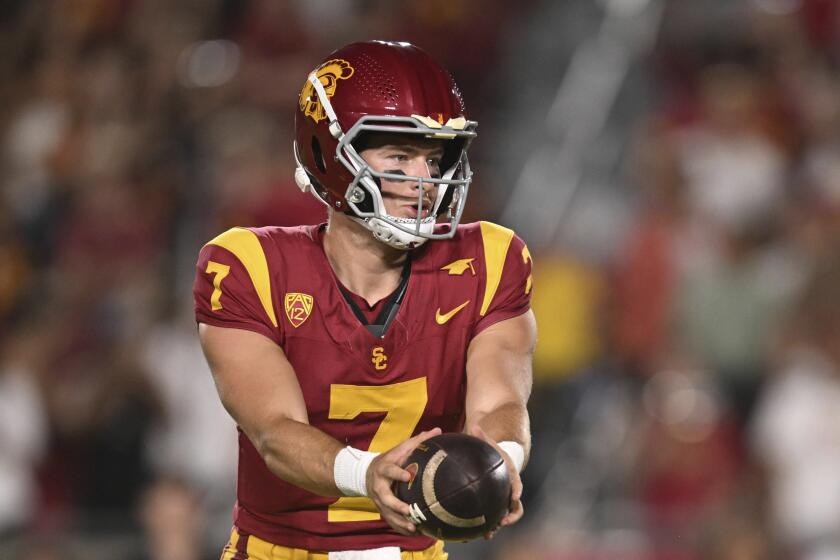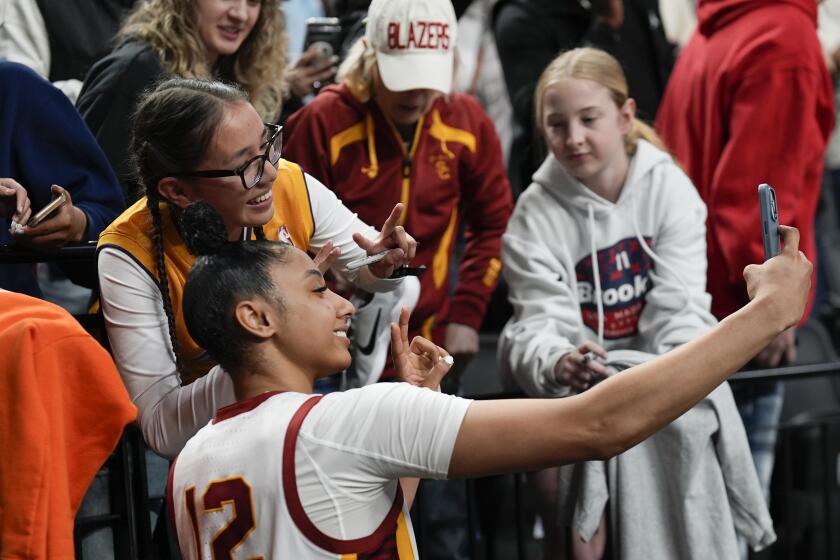USC-Texas revisited: A look at the little plays that set up the game-changers

Matt Leinart, Vince Young, Lendale White and others recount the 2006 national championship game between USC and Texas at the Rose Bowl. The Longhorns beat the Trojans, 41-38.
The first domino fell long before the fourth-and-two and Vince Young’s fateful run.
Take back the last 11 years, run back the game of the century from the beginning and the thing that might have done USC in, the thing that changed it all, was … a rolled ankle?
USC’s former players are thinking about that game again, the 2006 Rose Bowl against Texas, as the teams prepare to play on Saturday for the first time since that night. Some of them never stopped thinking about it.
The rest of the world remembers that the game was won on that fourth-and-two failure and the brilliance of Young. And it was.
Those things and a few far less obvious.
“Most people just chalk it up to a six-inch loss” — the distance USC fell short on the fourth-and-two — “but it was a lot of mistakes that we made throughout that game,” former Trojans cornerback Justin Wyatt said. “I don’t want to just chalk it up to that one fourth down.”
For a handful of USC’s players, the game did not turn on two epic plays, but rather on a series of tiny incidents, fractional mistakes and dumb luck.
Wyatt would know. He was brought down by that rolled ankle, though it wasn’t his own.
The ankle injury created a cascade of consequences, choices and bad breaks that no one envisioned at the time and no one thought much of afterward — except for the players involved. They knew that had any one of those things gone differently, USC might have won.
And it wasn’t just the rolled ankle that torments the Trojans. USC’s first loss in 35 games also required flukes of circumstance — otherwise benign substitutions or unexplained defensive switches — any of which could have changed the outcome.
Including circumstances before the game.
::
Game Week
Chris McFoy thinks back on the practice and wonders.
McFoy was USC’s No. 3 receiver, more an excellent blocker than star pass catcher. But he was reliable. USC players knew whenever they busted into the secondary McFoy would be there, clearing the way.
And so, during one bowl practice, Reggie Bush pulled him aside and told him he wanted to try something crazy.
At Bush’s request, McFoy trailed him after a long catch and run. Way downfield, Bush flipped the ball back to him.
“We did it a few times … jokingly,” McFoy said. “But it was kind of like, he always knew where I was at, you know?”
McFoy just had to be on the field.
First quarter
After USC’s first drive sputtered, the Trojans got the game’s first break when Texas muffed the punt.
Matt Leinart soon lofted a pass down the sideline. His target made a leaping catch, sustained a wicked helmet-to-helmet blow, yet hung on to the ball. The play of the game to that point was made by David Kirtman, a role-playing fullback.
The depth of USC’s talent made substituting a fraught choice. Usually, USC coach Pete Carroll stockpiled players with different talents. Bush had the speed; LenDale White had the brawn.
At fullback, the Trojans had Brandon Hancock, a powerful blocker and fierce runner. And then there was Kirtman, with hands like butterfly nets.
USC chose right early. Kirtman’s catch set up USC’s first touchdown.
There was a different choice to come.
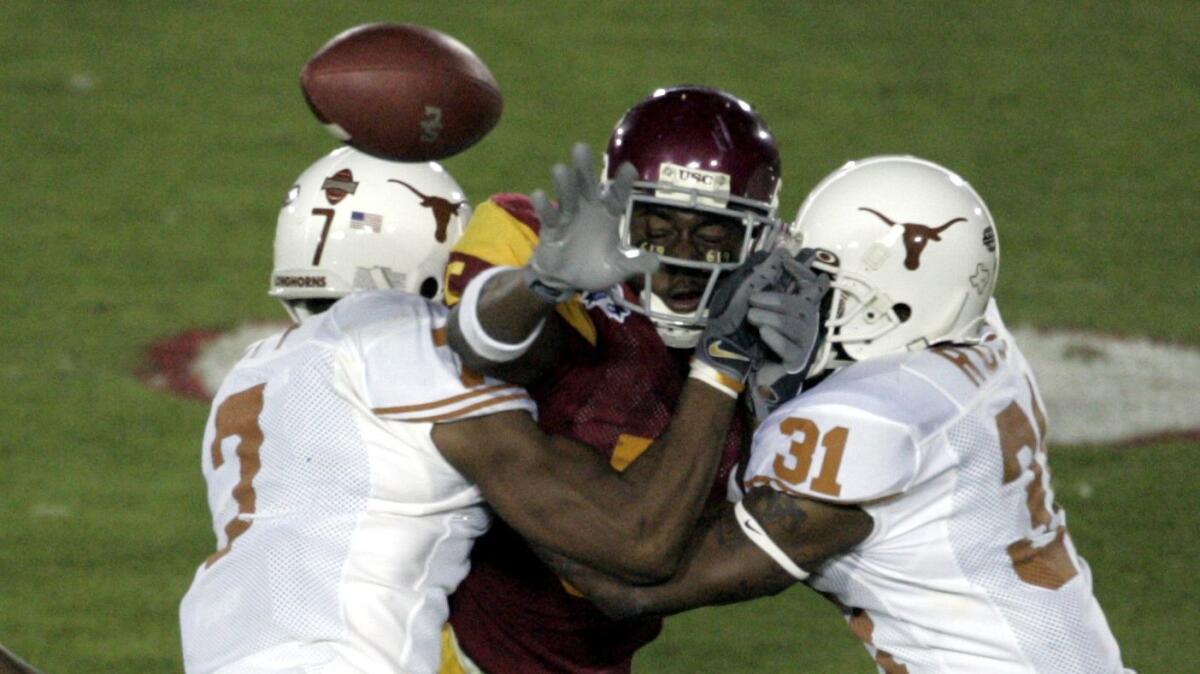
Second quarter
Bradley Walker is now a lawyer in the Orange County district attorney’s office.
People still ask him about one play from his previous life as a USC receiver.
“And it’s always kind of an awkward conversation,” Walker said. “Some people, you know, some people think that I was in the wrong. Other people think Reggie was in the wrong.”
USC was leading 7-0 and threatening to break the game open. Bush caught a screen pass and jitterbugged past a diving tackler and exploded into the open field. Then, as three Texas defenders took him down, he did something that went without explanation for a decade.
He pitched the ball backward.
The question of the game: Why did Bush flip the ball at all?
The question of the game for Walker was different: Why did Bush flip it to me?
Two people knew, and one of them was Bush.
The other, the victim of an untimely substitution, was standing on the sideline.
McFoy would later think: If he’d been there, as he and Bush had practiced, would USC have pulled away?
Fourth quarter
The rolled ankle, the one that wreaked so much havoc, was so minor that it wasn’t even mentioned on the television broadcast.
Cornerback John Walker had been covering Limas Sweed, Texas’ No. 1 receiver. Walker prided himself on sportsmanship, but Sweed had been talking smack. For some reason, Walker couldn’t resist. They started mixing it up after a play. Sweed gave him a little yank, not even hard, on the jersey.
And Walker’s ankle, one that had already been injured, rolled over.
Years later, Walker has a wife, two kids and a successful athletic performance training business. And is still stuck on that play.
He hobbled off the field. Kevin Thomas, a freshman — a freshman reserve, in the fourth quarter of the national championship game — jogged on.
A domino had tipped.
::
The famous fourth and two, when Texas saved the game by stopping White short of a first down, almost didn’t happen.
On second down, Hancock, the fullback, ran a short out route. What he remembers is the open grass. It signified first down. Game over.
If only he could have hung on to Leinart’s pass.
“People say, ‘Hey man, you lost that game,’” Hancock said. “I don’t really see it that way. I thought the ball was uncatchable personally, but everybody has their opinion.”
Leinart believes he could have placed the ball better. He had to change his arm angle to avoid a rusher, and when he did, his pass came in low.
“It was nobody’s fault,” he said. It was kind of just one of those things.”
It still might have been reachable, for the fullback with those butterfly net hands.
Standing on the sidelines, out of the game that play, was Kirtman.
::
USC still led, 38-33, when Texas got the ball back. But John Walker’s injury had set off its chain reaction, knocking over dominoes, creating a frenzy on the Trojans’ sideline.
Thomas was Walker’s initial substitute, but before the last drive someone had second thoughts. A coach was calling for a different freshman, Cary Harris.
“I was on the other side of the sideline,” Harris recalled. He was getting ready for special teams. “And they were calling like, ‘Cary! Cary! Where you at? Where you at?’ So I was trying to run over to get in for that last series.”
He didn’t hear in time, and the second domino fell.
With Thomas in, cornerback Wyatt lined up on Young’s on right side. Wyatt, a veteran, knew Young would keep probing the right because he was right-handed and could most easily roll out to that side.
But for some reason, Wyatt was soon switched to Young’s left. The last domino.
On the broadcast, Keith Jackson began his famous call: Fourth and five…
“I had the greatest seat in the freakin’ stadium,” Wyatt said. “And I couldn’t do anything about it.”
… The national championship on the line right here ...
Young took off — to his right. He scanned for the pass first, but his receivers were covered. So he took off. It was a race, but Young had the head start. Preoccupied with Sweed, Thomas turned his head for a moment.
… He’s going for the cornerrrr!
John Walker watched from the sidelines. Hancock watched from the sidelines. McFoy and Brad Walker and Bush watched from the sidelines. Wyatt watched from the other side of the field.
They knew what was going to happen before they heard the roar.
Follow Zach Helfand on Twitter @zhelfand
More to Read
Go beyond the scoreboard
Get the latest on L.A.'s teams in the daily Sports Report newsletter.
You may occasionally receive promotional content from the Los Angeles Times.
